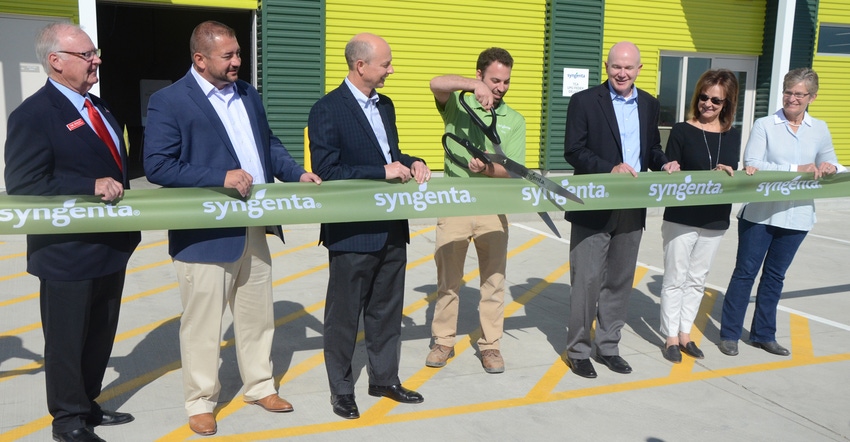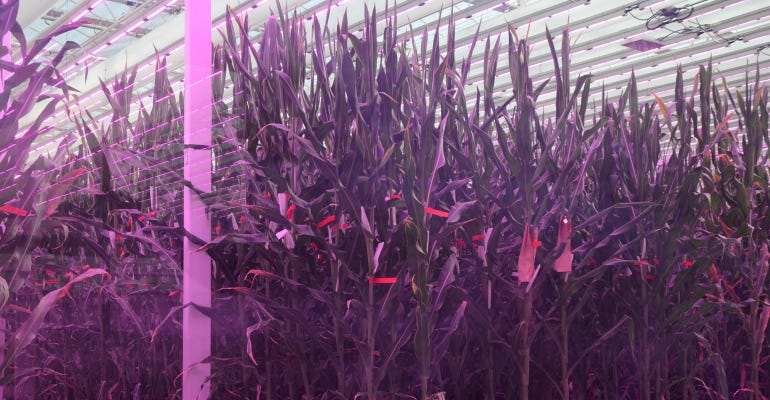
Unlike the other "I" states, Idaho isn't known for corn production. But that doesn't mean it isn't a great place for a corn breeding facility. Nampa, Idaho's dry climate, sunny days and relatively mild winters make it well-suited to breeding corn — and that's one reason Syngenta chose the town as its site for its Trait Conversion Accelerator facility.
At the new $30 million facility's grand opening this summer, Syngenta global head of seeds development Trevor Hohls pointed out Syngenta already has an established presence in Nampa with its vegetable and large-seeded crop research and development site.
"When we think about the investment we've made in our greenhouse facility, although we move into a more controlled environment, we still rely on climatic factors such as solar radiation," Hohls says. "Fortunately, in Nampa we've got more than eight months of sunshine. But it's also the temperature, and it's the relative humidity. When we have really high temperatures in the summertime, it's advantageous for us to not have the relative humidity be very high as well. In the wintertime, it's also advantageous to have very mild temperatures."
The Trait Conversion Accelerator facility was designed to speed up germplasm and trait development in a way that improves yield. Ultimately, David Hollinrake, North America regional director for Syngenta, notes the facility is intended to bring more choice in Agrisure traits and genetics for corn growers.
This includes products available through Golden Harvest and NK brands, and independent seed companies that license genetics through Syngenta's GreenLeaf Genetics.
"In the past, we have been doing breeding work by chance," Hollinrake says. "I say 'by chance' because we were doing it in an outside, uncontrolled environment. Being able to bring it into a controlled environment where you can regulate the temperature, the nutrients, the sunlight, etc., is a big step."
"With the use of revolutionary data capabilities, we can take snippets of plants, understand whether or not the appropriate trait was introgressed into that plant, and then advance the process by keeping the great plants and discarding the ones that didn't meet the necessary quality standards," Hollinrake says. "That's an important thing you really can't do in an outside environment. This means bringing products to market faster with greater confidence growers are going to have the traits that are necessary."

INDOOR CLIMATE: The greenhouses at the facility are equipped with LED lighting to maintain ideal plant health at an optimum photosynthetic level throughout the course of the cycle. The lights project on the red and blue spectrum, giving the greenhouses a purple glow.

How does the facility speed up this process? One of the first steps is the embryo rescue process, site manager Joe Bevilacqua explains.
"Instead of going from seed to seed every generation, we go from seed to embryo, then embryo to embryo, and finally from embryo to seed," Bevilacqua says. "That allows us to save several weeks per cycle throughout the year. Those weeks add up, enabling us to reach four cycles in later-maturing varieties. For earlier-maturing varieties, we can get even more than four cycles per year."
The facility's greenhouses are equipped with LED lighting to maintain ideal plant health at an optimum photosynthetic level throughout the course of the cycle. Greenhouses also are equipped with automated irrigation systems and fertilizer injection systems with pH adjustment to keep plants at a healthy state.
The lights project in the red and blue spectrum, giving the greenhouses a purple glow. Bevilacqua says these are the spectra where plants are the most photosynthetically active, called photosynthetically active radiation.
The facility also uses DNA markers to identify populations of plants with above-average genetic gain — also cutting back on time and costs to get a finished product.
"Instead of doing four or more backcrosses to get a finished conversion, we now only need two to three to get the final traited inbred," Bevilacqua says. "It allows us to pick the best plants from a large population of plants and only advance those individuals through the pipeline. Running these markers also ensures we introgress our traits of interest that will ultimately be used in hybrids sold growers."
Near term, Syngenta is focusing on increasing the rate of genetic gain for what's already commercially available, including Agrisure Viptera, Duracade and Duracade 5222, as well as Enogen and Enogen Feed.
Over the long term, however, the site is working on additional aboveground and belowground technologies, herbicide tolerance, and using gene editing to identify alleles in the plant to push yields and protect from diseases.
"Growers need us to bring innovation to the market faster to address their short- and long-term needs and provide solutions to their challenges," Hollinrake says. "To do this, we're scaling up our technology, our data and our talent. We're investing in technologies and capabilities, including digital and data science, but more importantly, it's really about how we use this technology to speed up the rate of gain and provide more choice."
About the Author(s)
You May Also Like






